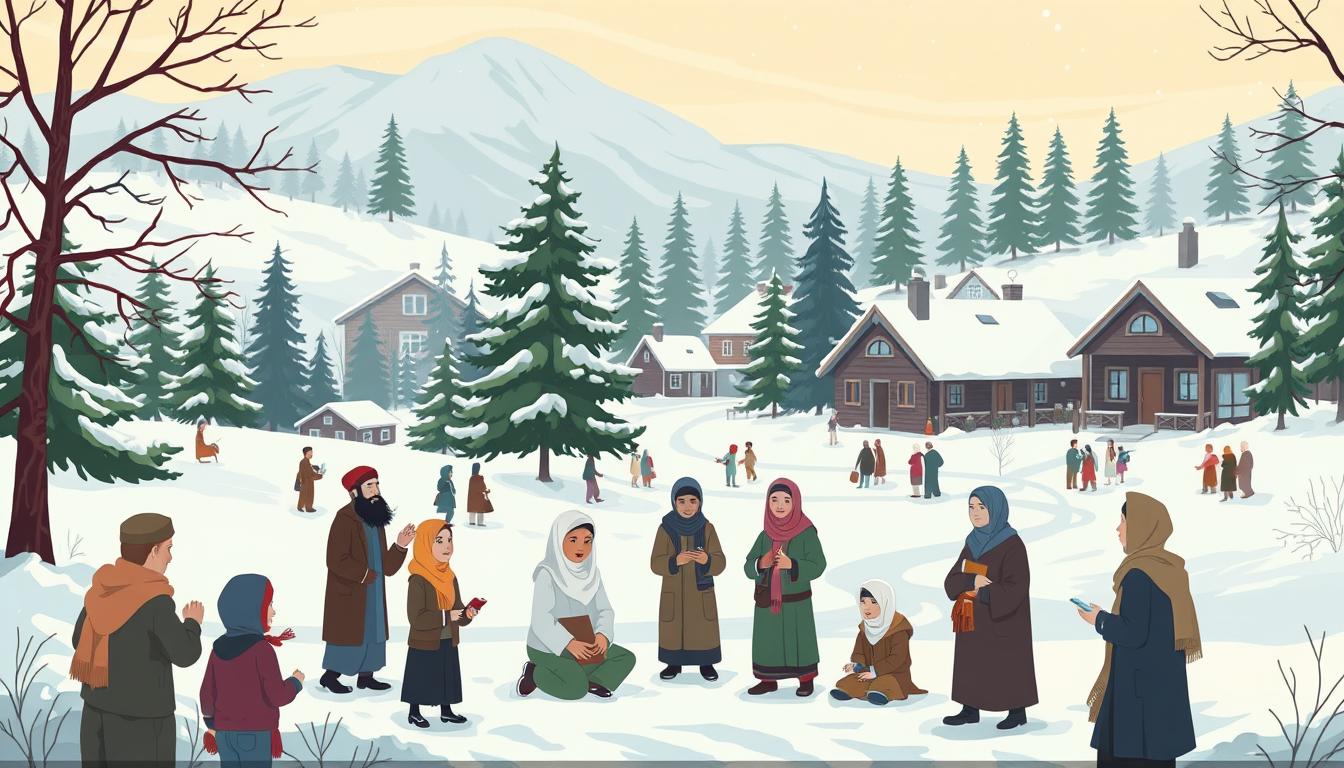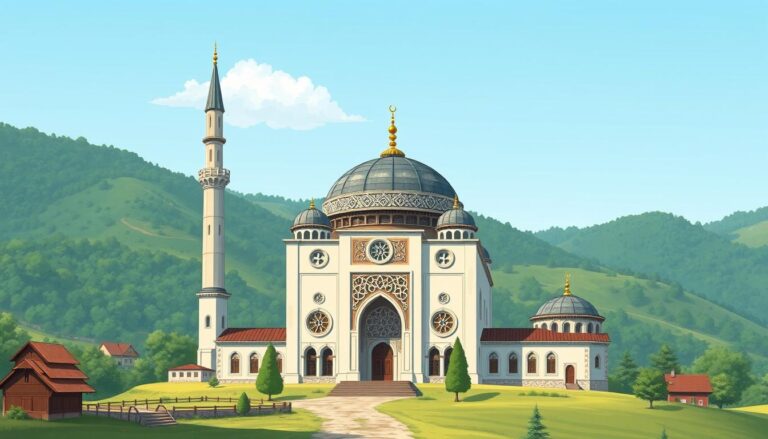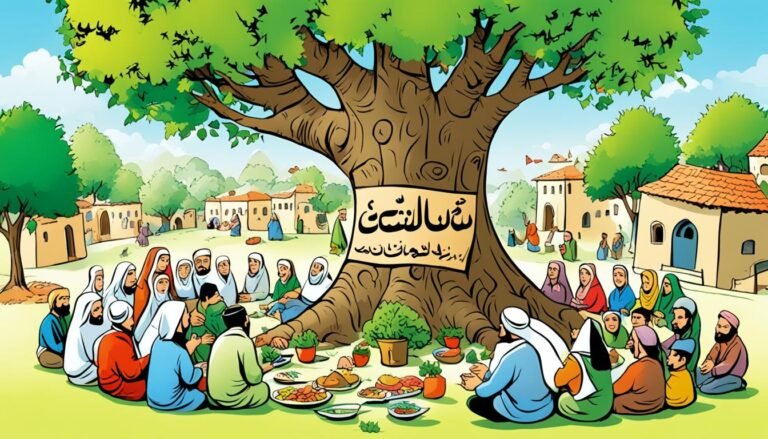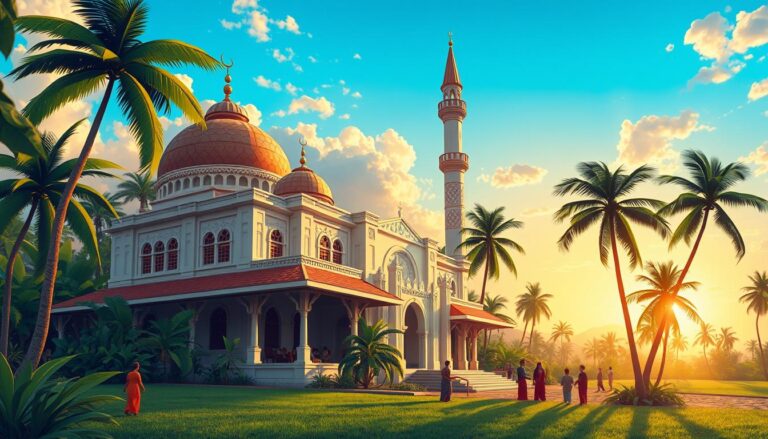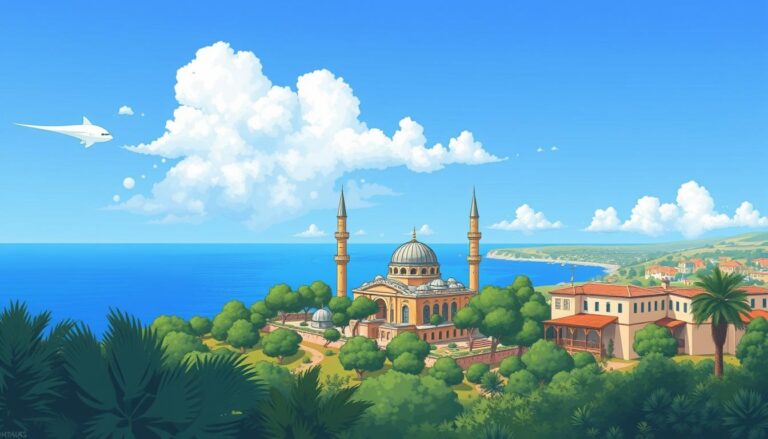Islam in Norway
With a population of over 182,607 Muslims, accounting for 3.4% of Norway’s total, Islam has firmly established itself as the second-largest religion in the country after Christianity. The vast majority of Norwegian Muslims are of immigrant background, with the Sunni sect being predominant, though a significant Shia minority also resides within the community.
Interestingly, more than half of Norway’s Muslim population, 55%, is concentrated in the Oslo and Viken regions, highlighting the uneven geographic distribution of this religious minority. The official registration of Muslims in Norway’s national statistics began in 1980, when the population was just 1,006 individuals, a stark contrast to the present-day figures.
Key Takeaways
- Islam is the second-largest religion in Norway, with over 182,607 Muslims (3.4% of the population) as of 2020.
- The majority of Norwegian Muslims are of immigrant background, with the Sunni sect being predominant and a significant Shia minority.
- 55% of Norway’s Muslim population is concentrated in the Oslo and Viken regions.
- The official registration of Muslims in Norway’s national statistics began in 1980 with just 1,006 individuals.
- The growth of the Muslim population in Norway highlights the increasing diversity and integration of this religious minority within Norwegian society.
Introduction to Islam in Norway
The presence of Islam in Norway has a relatively short history compared to other Western European countries. Muslim immigration to Norway did not gain momentum until the latter half of the 20th century. The History of Islam in Norway is marked by distinct waves of Muslim immigration that have shaped the Demographics of Norwegian Muslims over time.
Historical Overview of Muslim Migration to Norway
The first significant influx of Muslim immigrants to Norway came in the late 1960s, with the arrival of Pakistani laborers. In 1975, Norway halted labor immigration, but family reunification rules remained relatively relaxed, leading to continued growth in the Muslim population during the 1980s and 1990s. This period saw an increase in asylum seekers from Muslim-majority countries, including Iraq, Somalia, and Bosnia.
Demographic Breakdown of Norwegian Muslims
- The largest immigrant communities from Muslim countries in Norway are from Pakistan, Iraq, and Somalia.
- Other significant Muslim groups include Turks, Moroccans, Bosnians, Iranians, Kosovars, and Somalis.
- The degree of organization among Norwegian Muslims is exceptionally high compared to Sweden and Denmark, where the total percentage of Muslims is higher.
The diversity of Islamic traditions represented in Norway reflects the varied backgrounds of its Muslim population, including Barelwis, Jamaat-i-Islami, Minhaj-ul-Quran, Tabligh-i Jamaat, Diyanet, Suleymanic, Milli Görüs, and Bektashi.
Muslim Population Statistics in Norway
Norway’s Muslim population has seen a steady increase in recent decades, reflecting the country’s growing diversity. According to official statistics, the number of Muslims in Norway was first registered in 1980, when it stood at 1,006. However, the actual number was likely higher, as not all Muslims were members of a mosque at the time.
By the late 1990s, the proportion of Norwegian Muslims who were members of a mosque had risen significantly, from an estimated 10% in 1980 to 70% by 1998. The registered number of mosque members increased to 80,838 in 2004 before dropping to 72,023 in 2006. As of 2009, there were 126 registered Muslim congregations in Norway, with more than 40 prayer locations just in the city of Oslo.
More recent data suggests that the Muslim population in Norway has continued to grow. In 2017, Muslims made up 8.7% of Oslo’s population, and nearly 31% of the city’s residents were immigrants or individuals born to immigrant parents. The largest ethnic group among the immigrant population in Oslo is Norwegian Pakistanis, with an estimated 40,000 individuals.
Estimates indicate that the overall Muslim population in Norway ranged from 120,000 in 2005 to 163,000 in 2009. Additionally, Norway has seen a rise in the number of Norwegians converting to Islam, with reports suggesting up to 3,000 new converts in recent years compared to 500 in the 1990s.
These statistics reflect the changing religious landscape in Norway, where the proportion of the population belonging to the Evangelical Lutheran Church has declined from 96% in the 1960s to 68.7% as of 2019. Meanwhile, the number of Norwegians not affiliated with any official religious or philosophical community has increased to 18.3%, and the percentage of the population belonging to other religious or philosophical communities, including Catholics and Muslims, has grown to around 13%.
Islam in Norway: Historical Roots
The history of Islam in Norway can be traced back to the early days of the country’s interactions with the Muslim world. According to Icelandic annals, representatives from the Muslim sultan of Tunis arrived in Norway as early as the 1260s, after King Håkon Håkonsson had sent embassies to the Sultan with rich gifts. However, the presence of Muslims in Norway remained relatively small until the latter half of the 20th century.
Early Muslim Presence in Norwegian Annals
The early Muslim presence in Norway is documented in historical records, with the Icelandic annals providing the earliest accounts. These annals suggest that the first documented contact between Norway and the Muslim world dates back to the 13th century, when King Håkon Håkonsson established diplomatic ties with the Muslim sultan of Tunis. This exchange of embassies and gifts marked the beginning of a history of Islam in Norway that would become more prominent in the centuries to come.
“Icelandic annals date the arrival of representatives from the Muslim sultan of Tunis in Norway in the 1260s, after King Håkon Håkonsson had sent embassies to the Sultan with rich gifts.”
Despite these early historical connections, the Muslim population in Norway remained relatively small until the late 20th century, when waves of immigration from Muslim-majority countries began to reshape the country’s demographic landscape.
Waves of Muslim Immigration to Norway
Norway has witnessed several waves of Muslim immigration over the decades, driven by a diverse set of reasons. Muslim immigration to Norway can be broadly categorized into two main groups: labor migrants and asylum seekers.
Labor Migration and the Oil Boom
During the oil boom of the 1970s and 1980s, labor migration to Norway saw a significant increase. Migrants from countries like Pakistan, Turkey, and Morocco sought economic opportunities in the thriving Norwegian economy. This labor migration trend lasted longer in Norway compared to other European countries, as noted in the first source.
Asylum Seekers from Conflict Zones
In the 1980s and 1990s, asylum seekers from war-torn regions such as Somalia, Iraq, and Afghanistan became the dominant group of Muslim immigrants to Norway. They fled their home countries to escape conflicts, famine, and poverty, as mentioned in the third source.
The influx of asylum seekers during this period contributed to the growing Muslim population in Norway, which now accounts for approximately 4% of the total population, according to recent estimates.
“Even under a ‘zero migration’ scenario, the Muslim population in Europe is projected to rise to 7.4% by 2050 due to high fertility rates and a younger demographic compared to other Europeans.”
As Norway continues to grapple with the challenges and opportunities presented by its diverse Muslim population, understanding the historical patterns and drivers of Muslim migration to Norway remains crucial for policymakers and researchers alike.
Religious Practices and Identities
As the Muslim population in Norway continues to grow, understanding their religious practices and identities has become increasingly important. According to studies conducted in 2006 and 2007, around 18% of Norwegian Muslims reported visiting the mosque once a week, while 36% of Muslim youth visited the mosque less than once a month.
A 2007/2008 survey of students at upper secondary schools in Oslo found that 25% of Muslims pray regularly, and 12% attend religious services weekly. This data suggests that the level of religious observance among Norwegian Muslims varies, with some maintaining strong ties to their faith while others are less actively involved in mosque attendance and prayer habits.
“Approximately 65% of the population in Norway belongs to the Church of Norway, showing a decline of 4.9 percentage points over the previous three years.”
The religious landscape in Norway is undergoing a gradual transformation, with the proportion of the population identifying with the Church of Norway declining in recent years. This shift has coincided with an increase in the number of Norwegians belonging to religious and life-stance communities other than the Church of Norway, including the growing Muslim population.
Islam in Norway
Islam has had a significant presence in Norway, with the religion becoming the largest minority faith in the late 1990s, surpassing the Roman Catholic Church and Pentecostalism. However, by 2013, the Roman Catholic Church regained its position as the largest minority religion due to increasing immigration from European countries and a decline in Muslim immigration.
The Muslim population in Norway is diverse, with adherents from various backgrounds and nationalities. They have established vibrant Muslim communities in Norway that contribute to the country’s religious and cultural landscape. These Norwegian Muslims engage in various religious practices, such as mosque attendance and regular prayer habits.
“Islam passed the Roman Catholic Church and Pentecostalism to become the largest minority religion in Norway in the late 1990s, provided Islam is seen as one group.”
Despite the growing presence of Islam in Norway, the public opinion and attitudes towards Muslims have been somewhat complex. Surveys have revealed that a significant portion of the Norwegian population holds prejudices against Muslims, with some perceiving them as a threat to Norwegian culture. Additionally, instances of discrimination, hate speech, and attacks on Muslim individuals and institutions have been reported.
- In a 2012 survey, 66% of respondents reported they would “strongly dislike” or “dislike” a Muslim being married into their family.
- A 2012 study found that job applicants with Pakistani-sounding or Muslim-sounding names received 25% fewer callbacks from employers in Norway compared to Norwegian applicants with similar qualifications.
- The first-ever sentence against a Norwegian citizen for hate speech targeting a Muslim was issued in October 2014.
Despite these challenges, the Muslim communities in Norway continue to play an active role in the country’s social, cultural, and political spheres. The Norwegian government has also taken steps to combat discrimination and hatred towards Muslims, demonstrating a commitment to fostering a more inclusive and tolerant society.
Public Opinion and Attitudes Towards Muslims
In Norway, a country often lauded as one of the happiest in the world, the public’s attitudes towards Muslims have been a topic of growing interest. Several surveys have shed light on the integration of Muslims and their religious values within the Norwegian society.
A 2016 survey found that the vast majority of Norwegian Muslims, around 98%, believed that human rights are important. Additionally, 94% considered democracy to be crucial, and 95% expressed a desire to live in peace with non-Muslims. However, a notable minority of 47% said that it is not important to follow Sharia law.
Surveys on Islamic Values and Integration
Another survey conducted in 2017 revealed that 3 out of 10 Muslims in Norway agreed that it is important to follow Sharia law. This suggests a diversity of views within the Muslim community when it comes to the integration of Islamic values and practices.
Interestingly, research has shown that the level of negative attitudes towards Muslims tends to decrease as the relative size of the Muslim population increases in a given area. This indicates that exposure and familiarity can play a significant role in shaping public opinion and attitudes towards this minority group.
“Schools in Norway are seen as important socializing contexts outside of the family, providing opportunities for interactions across ethnic and religious lines.”
As the Muslim population in Norway continues to grow, driven by factors such as labor migration and asylum seekers, the integration of this community and the public’s perception of it will undoubtedly remain a topic of ongoing discussion and research.
Socioeconomic Status of Norwegian Muslims
Norway has long been recognized for its commitment to promoting equality and social welfare. However, the socioeconomic status of Norwegian Muslims reveals a more nuanced reality. While education is highly valued in Norwegian society, Muslim immigrants may face unique challenges in accessing employment opportunities commensurate with their qualifications.
A study by Brekke and Mastekaasa (2008) found that highly educated immigrants in the Norwegian labor market can face persistent disadvantages, highlighting a potential correlation between education level and employment status. This suggests that even as Muslim youth in Norway receive equal educational opportunities, they may encounter barriers when transitioning into the workforce.
Education and Employment Opportunities
According to a 2005-2006 study, 19% of Muslim immigrants were employed in academic and administrative occupations, while 58% worked in skilled sectors and 17% in unskilled roles. This data suggests a diverse range of employment outcomes, with some Muslims thriving in professional fields but others struggling to find work commensurate with their skills.
Citizenship Acquisition and Community Associations
The acquisition of Norwegian citizenship is an important indicator of integration, and studies show that 67% of Muslim immigrants have obtained Norwegian citizenship. However, this rate is lower for certain groups, such as those from Iraq and Somalia.
Alongside these individual achievements, Muslims in Norway have also been active in establishing community associations. Data indicates that more than 90 such organizations exist, with the majority located in Oslo, the capital city. These associations play a vital role in fostering a sense of belonging and providing support for the Muslim community.
In summary, the socioeconomic status of Norwegian Muslims presents a complex picture. While education is highly valued, employment barriers persist, and citizenship acquisition rates vary across different immigrant groups. Nevertheless, the vibrant network of community associations demonstrates the resilience and adaptability of Norway’s Muslim population.
Political Participation of Norwegian Muslims
While the Muslim community in Norway, comprising over 100,000 individuals, has steadily integrated into the country’s socioeconomic fabric, their political representation remains a work in progress. Currently, only 11 out of the 169 lawmakers in Norway’s parliament represent visible minorities, a figure that does not fully reflect the growing diversity of the nation’s population.
Despite these challenges, Norwegian Muslims are increasingly engaged in the political process, with the Labor Party attracting a significant share of their votes due to its socioeconomic policies. Hadia Tajik, a Norwegian of Pakistani descent, made history in 2012 by becoming the youngest and first Muslim minister in the Labor Party government.
The 2021 Norwegian parliamentary elections saw the election of Marian Hussein, the first Black woman to enter the Norwegian parliament and the first to wear a hijab in office. Hussein’s victory has been celebrated as a positive step towards greater diversity and inclusion in Norwegian politics, inspiring young Muslims like Yasmin Mohammed to engage more actively in the political process.
“I feel more included in Norwegian society because of politicians like Marian Hussein. It makes me want to read more about politics and explore opportunities to get involved.”
While challenges persist, the increasing political participation of Norwegian Muslims and their representation in Norwegian politics are steadily shaping the country’s democratic landscape, fostering greater dialogue and inclusion.
Despite the progress, concerns have been raised by some non-Muslim Norwegians about the impact of Muslim traditions, such as male circumcision, Islamic dietary laws, and the wearing of the hijab. These issues have at times contributed to tensions between the Muslim community and the broader population. However, Norway’s political establishment has sought to engage in constructive dialogue with the Muslim community, aiming to integrate their perspectives into the policymaking process.
Challenges and Issues Faced by Muslims
Norwegian Muslims have faced various challenges and issues, particularly in the post-9/11 era. The Challenges faced by Norwegian Muslims have included instances of Discrimination and Islamophobia, as well as Religious controversies.
Since the 9/11 attacks, profiling and unjust practices against Muslims in Norway have become more common. Discrimination against Muslims has been reported in the Center for International Human Rights’ reports. Notably, the publication of offensive caricatures of the Prophet Muhammad in Norwegian media sparked protests from the Muslim community.
Post 9/11 Discrimination and Islamophobia
The ultra-right-wing terrorist attack by Anders B. Breivik in 2011, which targeted a Labor youth camp, may have been a factor in the election of the first Muslim minister, Hadia Tajik.
Controversies over Religious Symbols and Expressions
In Norway, there are specific restrictions on the construction and use of mosques, the display of religious symbols or dress codes at work or in public places, and the conduct of prayers or religious ceremonies in public. Additionally, the slaughtering of halal meat is permitted, subject to complying with Norwegian animal welfare provisions.
The Norwegian government is reportedly preparing legislation to enable state authorities to create lists of alleged ‘hate speech propagators’ to be barred from entry. These challenges and issues highlight the need for continued dialogue and understanding between the Muslim community and Norwegian society.
Conclusion
Norway has a significant Muslim minority, comprising around 3.4% of the total population as of 2020. The Muslim population in Norway is diverse, with the largest immigrant communities coming from Pakistan, Iraq, and Somalia. While Muslims in Norway generally enjoy equal rights and opportunities, they have faced challenges such as discrimination, Islamophobia, and controversies over religious expressions. The integration of Muslims into Norwegian society remains an important and ongoing topic of discussion.
Despite the challenges, the Muslim community in Norway has become an integral part of the country’s social fabric. They contribute to Norway’s economy and participate actively in political processes, with figures like Hadia Tajik serving as the country’s first Muslim minister. As Norway continues to grapple with issues of diversity and integration, understanding the nuances of the Muslim experience in the country will be crucial in fostering a more inclusive and harmonious society.
The Summary of Islam in Norway highlights the complex and evolving relationship between the Muslim minority and the larger Norwegian society. While progress has been made, there is still work to be done to address lingering prejudices and ensure equal opportunities for all. By embracing diversity and promoting intergroup contact, Norway can build a future where Conclusion of the Muslim community is celebrated as a valued part of the nation’s rich cultural tapestry.
Source Links
- Islam in Norway
- Norway and Islam – İnsamer – İnsamer
- Why did Muslims become the new enemy in Norway and Europe? – C-REX – Center for Research on Extremism
- No title found
- Microsoft Word – Document1
- Muhammad is the top name in Oslo again
- Religion in Norway
- Norway – United States Department of State
- Why Did Muslims Become the New Enemy in Norway and Europe? – PRIO Blogs
- Islam in Norway –
- Attitudes Toward Muslims Among Majority Youth in Norway: Does Ethno-Religious Student Composition in Schools Matter? | Nordic Journal of Migration Research
- Europe’s Growing Muslim Population
- Norway – United States Department of State
- Islamophobia in Norway
- Attitudes Towards Muslims & Islamophobia in Norway
- In Norway, Negative Attitudes Toward Muslims Are Still Widespread
- Norway – United States Department of State
- No title found
- Complicating hate speech matters
- Once sidelined, Norway’s migrant minorities earn a voice in parliament
- The Muslims of Norway
- Norway – United States Department of State
- The Islamization of Oslo

